Interview with Joy Overstreet
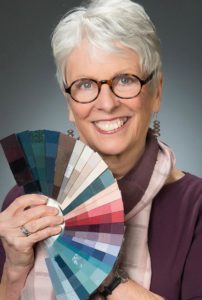 Now that we’re well into the summer season—my very favorite—I’d like to introduce you to Joy Overstreet, a color consultant, who utilizes seasonal influences in her work with people around color. Joy is an exceptionally interesting, vibrant woman who follows her infinite curiosity! In addition to work with color, Joy is a writer. She has a wonderful newsletter “Alive with Joy!” and will soon be publishing her book Becoming Thin Within based on the very successful diet-free program she created in the 70s. Joy, who looks for beauty in everything, is also quite an accomplished photographer. Please enjoy her words, her energy, and her photographs, all of which I am grateful she shared with me in this interview.
Now that we’re well into the summer season—my very favorite—I’d like to introduce you to Joy Overstreet, a color consultant, who utilizes seasonal influences in her work with people around color. Joy is an exceptionally interesting, vibrant woman who follows her infinite curiosity! In addition to work with color, Joy is a writer. She has a wonderful newsletter “Alive with Joy!” and will soon be publishing her book Becoming Thin Within based on the very successful diet-free program she created in the 70s. Joy, who looks for beauty in everything, is also quite an accomplished photographer. Please enjoy her words, her energy, and her photographs, all of which I am grateful she shared with me in this interview.
Diane: Joy! Welcome! I came to you through a mutual connection, Nicky Mendenhall, whom I interviewed recently. (Her book is coming out in October, by the way.) Nicky mentioned you in one of her previous posts and I said, Wow, I think my readers would really be interested in you and in what you do. Can you tell us about yourself and your work?
Joy: I am a perpetually curious person. Curiosity and delight are what drive me. Looking for beauty in all things.
“I Am Just Completing a Book, Becoming Thin Within, Based on a Diet-Free Seminar Program I Created in 1974”
I have always worn many hats. I am paid now as a color consultant and create palettes for people’s wardrobes and homes. Until the pandemic, I taught classes at the local community college in color, style and downsizing. I’ve been trained in Feng Shui as well, which is a great complement to the color work. I am also a writer and am just completing a book, Becoming Thin Within, based on a diet-free seminar program I created in 1974, called Thin Within and based on mindfulness techniques. It was very popular in in the San Francisco Bay Area.
Diane: I heard you had a piece published in the NY Times!
Joy: I did. I wrote an essay about my older son, an industrial designer, who started a company creating very expensive vibrators.
Diane: Oh! I love that! How funny is that? Every mother’s dream.
Joy: I have three accomplished children. My son has since sold the business and is now working for a major design firm in France.
Diane: I read about how you got into the whole color thing. It’s a funny story and I was wondering if you’d share it with us.
Joy: I was eight months pregnant with my second child, the son who designed vibrators. I decided I should change out my wardrobe after the pregnancy and made an appointment with a personal color consultant. The whole seasonal color thing—”having your colors done”– was very big in California during the 1970s. My husband was a dress manufacturer and often brought home extra fabric, so I sewed many of my maternity clothes. I made this bright orange tent with a white and black panel inserted in the front because I didn’t have quite enough of the orange.
“I Am Not a Fashion Queen. I Am Interested in Style in That the Clothes Flatter You”
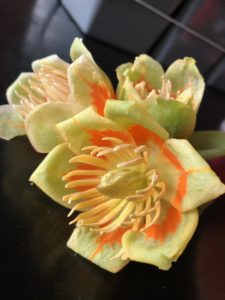 I love bright colors and I went to the appointment thinking the color consultant would be wowed by my outfit. He was, but not in a good way. He told me I looked best in soft muted colors because of the coolness of my skin, hair and eyes. (I’m a “rose-tone Summer” in the color analysis system we use.) There was no orange in my colors, no yellow. I was devastated because I didn’t think of myself as a soft muted person.
I love bright colors and I went to the appointment thinking the color consultant would be wowed by my outfit. He was, but not in a good way. He told me I looked best in soft muted colors because of the coolness of my skin, hair and eyes. (I’m a “rose-tone Summer” in the color analysis system we use.) There was no orange in my colors, no yellow. I was devastated because I didn’t think of myself as a soft muted person.
Diane: You didn’t think of yourself as muted.
Joy: No. The woman who owned the color studio offered a series of color classes for each “seasonal harmony”—Spring, Summer, Autumn and Winter– so we could understand how to work with our particular color palette, and how it translated into ways of combining colors and different clothing styles. Each season looks most authentic in certain types of clothing. Without pictures it’s hard to describe in less than a thousand words.
Diane: That’s interesting. So it’s a whole fashion …
Joy: I am not a fashion queen. I am interested in style in that the clothes flatter you – that fit right, make you look authentic and approachable, and reflect your seasonal personality.
Diane: Can you walk me through an appointment? What would it look like?
Joy: The first thing would be to take you into the hall and have you walk for me, to see how you carry yourself. It gives me a clue into your personality and season. Then I spend a half hour or so interviewing you to find out more about the kind of person you are–your work, hobbies, what your clothing issues are, how you see yourself and the image you want to project to others.
“When You Wear Your Best Colors, You Come Forward and Your Clothes Are Less Important”
 Diane: Sounds like therapy! Do some people find these questions hard to answer?
Diane: Sounds like therapy! Do some people find these questions hard to answer?
Joy: It has its moments!
It surprises them, but usually people know what they would like others to think. The answer is often that they want to feel more confident and credible. Authentic. They want to look authentic. That their best self, their essence comes forward first.
Diane: Got it.
Joy: When you wear your best colors, you come forward and your clothes are less important.
Diane: That stopped me on your website. People used to comment on your clothes. Then they started commenting on how you look, not just your clothes.
Joy: Exactly. We spend the next couple of hours with me holding up dozens of color sticks to the client’s skin, hair and eyes to see what colors bring the client forth. From there I create a harmonious palette of about 120 hues in fabric.
Diane: How did you get into this as a business?
Joy: When I had my colors done back in 1971, it was not the one palette per season “color me beautiful” kind of analysis. Each palette was created just for you. I was fascinated and took my color palette everywhere, so that I could educate my eye to get better at seeing the differences between the hundreds of greens, and blues, and so forth.
I went on with my life and did other things, but I always wanted to learn how to do it.
“When I Do a Color Consult for a Home, Just Like for a Person, I Have to Look at What the Givens Are”
 In 2000, my marriage was falling apart, and I decided I wanted to do something different. I trained as a Feng Shui consultant with Terah Katherine Collins in San Diego. It taught me a lot about creating a space that is intentional so that everything in that space positively reinforces who you are. (Not much different from what I do as a color consultant!)
In 2000, my marriage was falling apart, and I decided I wanted to do something different. I trained as a Feng Shui consultant with Terah Katherine Collins in San Diego. It taught me a lot about creating a space that is intentional so that everything in that space positively reinforces who you are. (Not much different from what I do as a color consultant!)
You can draw the eye to different parts of the room or house by how you place your art or your furniture so that it creates a good feeling. It was more about energy flow and directing your eye than following the bagua: this is your wealth corner; this is romance; this is health.
I started doing more with color with my feng shui and eventually stopped calling it feng shui and just helped people create paint palettes, hang art, and move furniture around so that it felt good.
When I do a color consult for a home, just like for a person, I have to look at what the givens are. If you’ve got a brick wall, we’ve got to deal with that. We have to have colors that will work with your brick wall, or the color of your flooring, or your woodwork.
It’s the same with a person. If you tell me you’re going to be coloring your hair forever, I have to work with that.
Diane: That was going to be my next question. Do people’s colors change as they grow older or…
“You Just Look More Comfortable in Your Own Skin, More Yourself”
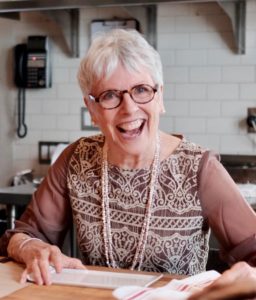 Joy: Definitely. If you’re a Summer, or a Winter, or a whatever, you’re still that, but because your skin fades, your eyes are not as bright, and …
Joy: Definitely. If you’re a Summer, or a Winter, or a whatever, you’re still that, but because your skin fades, your eyes are not as bright, and …
Diane: Ugh!
Joy: … and your hair changes color. It may not go all the way gray, but it softens in color. We have to deal with that. I have adjusted a number of palettes for people who go gray.
Diane: How do you respond to people who say, “Oh, that’s so shallow.” Do you get that a lot?
Joy: I sometimes get that from people who’ve not had their colors done. Once you’ve had your colors done, it frees you to only buy clothes that work for you. You save lots of money because you just don’t buy whatever your eye falls on, or whatever is on sale.
Then people start telling you how good you look. And when people are saying you look great…
Diane: Call me shallow, right?
Joy: Yeah, call me shallow. Your palette becomes a part of you, so you don’t even think about it. You just look more comfortable in your own skin, more yourself.
Diane: You look at people’s walks when they first come in. Do they walk differently after you’ve done their color? Like stand taller?
Joy: That could happen, but one thing that happens often is people tell me they feel truly seen.
Diane: Wow.
Joy: And that they’ve never felt seen before. It’s a very intimate process. And collaborative.
Diane: Do you do this in one session?
“You Don’t Realize How People’s Eyes Travel”
Joy: Yes. I do a quick assessment to figure out how much saturation they can handle, how much contrast and how warm or cool they are. (Most people are a mix, which is what trips them up.) For each of the four seasonal types, I have six base palettes going from dark to light or light to dark, and strong to more muted. I pick one or two sample palettes to try and then take those palettes apart. Color stick by color stick, I go through and hold a stick up to the person’s face, and eyes, or hair, and we discuss. They’re using a mirror as I’m looking, and we decide A or B, B or C, A or C, and then we construct the palette stick by stick that way.
I have them put their makeup on to make sure it goes with the palette, because it often doesn’t. They’ve picked the wrong foundation or the wrong lipstick. Or the wrong hair color.
Diane: That’s interesting. So, you advise on makeup and hair color.
Joy: For example, the colors that you are naturally, your hair, your skin, and your eyes are what we call inherent. They’re built-in, the givens. You don’t realize how people’s eyes travel. When they look at you–when they look at anything–their eyes travel in a certain direction, and are drawn to repetition, contrast and pattern.
When you wear your eye color, for example, people who are looking at you are drawn to your eyes, and if they look into your eyes, they’re more likely to trust you. If you’re trying to seal a deal, you want to wear your eye color.
“I Wrote the Essay, and the Editor Didn’t Like It… I Was So Crushed I Stopped Sending Stuff Out”
 If you want to look approachable, you’ll wear a skin tone…
If you want to look approachable, you’ll wear a skin tone…
For a romantic look, you would wear your blush or a version of your red.
Diane: Oh, so if you have blue eyes, you wear a shade that matches your eyes.
Joy: Exactly.
Diane: Let’s talk about your other hats. Tell me about your writing because your writing is lovely. I read a few of your blog pieces, and they’re really gorgeous. How did you start?
Joy: I always wanted to write, but I’m a terrible typist. So, in 1980, I bought a computer, and that changed everything … I could finally edit, because like most writers, I write really crummy first drafts, and second ones, and third ones, and fourth ones, and so it allowed me finally to write work that I was proud enough to send out. I was lucky enough to get published frequently, and then…
Diane: What kinds of stuff were you writing?
Joy: Mostly health-related stuff at the time because I had a Master’s in Public Health. I’ve always written nonfiction, including food writing. I wrote the food page for the Berkeley Gazette before it went belly up. I also wrote essays about family life because I was in the middle of it.
In 1987 or 88 I wrote several pieces for Working Mother Magazine, and they asked me to write something about my daughter going off to college…
… I wrote the essay, and the editor didn’t like it. I mean, when I say she didn’t like it, she said, “Mm. I don’t know. I don’t think that’s for us.” It’s not like she said, “This is terrible”! but I was so crushed that I stopped sending stuff out to be published.
Diane: Wow!
Joy: I know!
“It Was at Least Twenty Years Before I Got Up the Nerve to Send Something Out Again”
Diane: You were spoiled! You got all acceptances right from the beginning?
Joy: Well, I wrote stuff that I felt was going to be a sure thing. I continued to write, but I stopped writing essays. Just bread and butter articles for the Kaiser Foundation or the Blue Cross health system. Manuals for the Cancer Society, stuff like that.
It was at least twenty years before I got up the nerve to send something out again. I was also doing other things–I just stopped thinking of myself as a writer.
Diane: All from one rejection!
Joy: One rejection. I’m a lot tougher now that I was then.
Diane: That’s what growing older will do for you, right?
Joy: Exactly, yeah.
I’m also a photographer. I take a lot of pictures because I’m always out looking for beautiful things, so I have thousands and thousands of photos on my computer, and also thousands and thousands of thoughts in my head, and I’ve put that to use writing curriculum for classes, or about color and feng shui for my website.
Finally, couple of years ago, I decided I would write a book. I had never written anything longer than a couple thousand words aside from my public health thesis. I wanted to share the story of Thin Within, the weight loss program that I created in 1975.
Diane: Tell us about that.
“It Was About Switching That Pattern of Thinking … to Seeing Yourself as a Thin Person Who Behaves Like One”
 Joy: Thin Within was a program based on self-discovery. It was not a diet but a 7-week series of workshops, with 25 or so participants at a time, and a pretty heavy-duty assignment list of things that they had to do. It had nothing to with what you ate, but how you ate, and what you were thinking, and what you were avoiding—the stories and excuses you told yourself. The goal was to change how you see yourself as a fat person and behave in ways that reinforce that belief. Even if someone has lost weight by dieting, their self-image stays stuck.
Joy: Thin Within was a program based on self-discovery. It was not a diet but a 7-week series of workshops, with 25 or so participants at a time, and a pretty heavy-duty assignment list of things that they had to do. It had nothing to with what you ate, but how you ate, and what you were thinking, and what you were avoiding—the stories and excuses you told yourself. The goal was to change how you see yourself as a fat person and behave in ways that reinforce that belief. Even if someone has lost weight by dieting, their self-image stays stuck.
Diane: Yep.
Joy: So, it was about switching that pattern of thinking … to seeing yourself as a thin person who behaves like one.
Diane: Did you ever have weight issues?
Joy: I did. My first husband died of cancer in 1974, and I had two little children at the time, preschoolers. I was pretty overwhelmed, to say the least. My solution was to eat, and then to freak out about it. I spent way too much time and energy worrying about my weight. I felt stuck in a loop of self-loathing. It was horrible. I decided I had to find another way. It began with telling the truth to myself about what I was doing and why I was doing it.
Diane: That’s fascinating.
Joy: Think of the yin yang symbol … the seed of one extreme is in the other and vice versa. Which seed will you water? People who think of themselves as fat are always feeding that side of themselves, but the thin self is there; it’s just a question of nurturing it and bringing it to the front. That’s what Thin Within was about. It was a truly transformational process.
“I Could See That It Was Much Bigger Than the Individual”
 Diane: You started a business. It’s not just you have this idea, you’re also an entrepreneur.
Diane: You started a business. It’s not just you have this idea, you’re also an entrepreneur.
Joy: After I started the business, I took on a partner because I couldn’t do it alone as a single parent. We worked together to grow the business. It became very successful in the Bay Area.
Diane: I bet!
Joy: But quite honestly, even though I thought we were getting to the root of the problem, I’m always thinking about where the problem comes from upstream. It’s a public health mentality.
I thought that I was going upstream when I tossed dieting and started looking at what made people eat in the first place. Leading several classes a week, I was hearing all these stories and realizing that people had histories that went way back into how their parents raised them, the messages they got on television, the school lunch program …
I could see that it was much bigger than the individual. That is when I decided I should go to grad school. In 1980 I sold the business to my partner and went to University of California School of Public Health. My partner kept the business, then became a born-again Christian … and changed the program entirely. It was still not a diet, it was still about changing the way you think, but she…
Diane: Brought God into it?
Joy: She brought God, and the Bible, and biblical verses. It became an evangelical missionary tool for her. I was raised Unitarian Universalist—with Buddhist and Pagan leanings, so this really stung.
“I Recommend Just Following Your Curious Nose Even If You Don’t Know Where It’s Going to Go”
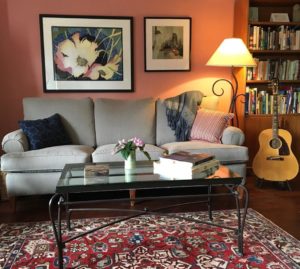 She wrote a book about it that was a big seller back in 2002, and she still has the program going in churches and online, still not a diet though.
She wrote a book about it that was a big seller back in 2002, and she still has the program going in churches and online, still not a diet though.
I wanted to share my original vision, my original material, because the ideas are so powerful. I’m almost finished my own book. It’s a how-to called Becoming Thin Within.
Diane: Wonderful! I’ll buy it! A lot of people are looking for a magic pill. They’re not going to find it here, which is good, because there is none. This type of book has a market built in right away. I imagine it will be a great success!
Joy: I hope so. I’m 80 for God’s sakes, and it was like, if I don’t do it now, it’s not going to happen.
Diane: You’re 80! You have amazing energy.
Joy: I am fortunate that way … So, I wanted to show you something.
Diane: Yes, please do. (Joy moves the camera around to show me her apartment.)
Joy: My apartment is in my colors. The wall color is my blush. My couch is gray like my hair, and there’s a blue throw on it someplace, and the curve… Do you see the curves of the lamp?
Diane: Yes, I do.
Joy: That’s a very summer line.
Diane: So interesting!
Do you had anything to say, words of wisdom to women who are in this getting older, finding- themselves-again type of place?
Joy: Yeah. I would say lighten up. Don’t take yourself so seriously.
“And Look for Beauty. It’s Everywhere”
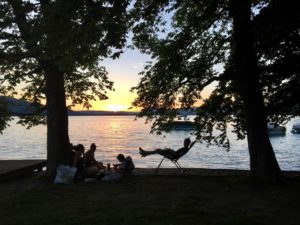 Diane: I love it!
Diane: I love it!
Joy: And I tell you, I think curiosity is the best thing ever. I recommend just following your curious nose even if you don’t know where it’s going to go, and just, if you’re interested in something, it might develop into something.
Diane: Yes, yes, yes.
Joy: And … And look for beauty. It’s everywhere.
Diane: Look for beauty. Wow. Well, I think that’s a wonderful place to stop, unless you have anything else you want to share.
Joy: One other thing. Take a class in improv.
Diane: And what does that do?
Joy: You become very aware that all life is improv … and that you can roll with the punches.
Diane: If you can do that, you can do anything, right?
Joy: There’s a book I love that turned me onto it, called Improv Wisdom. The woman who wrote it taught improv at Stanford for 30 years. She’s also a practicing Buddhist, and so it’s kind of a combination of improv philosophy and Buddhism. It’s a lot of fun and very inspiring. It’s my bible.
Diane: Wonderful. This has been such a delight. Thank you so much for taking the time.
Joy: Thank you for being interested.
Diane: Have a wonderful evening.
Joy: You too.
Learn more about Joy Overstreet in her free newsletter here
Subscribe: sign up here
Custom color palettes and personal style http://www.colorstylepdx.com/about-joy/
Color palettes for the home creatingjoyfulspaces.com
You can reach her [email protected]
360-903-3659 cell
As always, I’d love to hear your thoughts–about color or anything else on your mind!
Please leave a comment or send me an email.
See you August 3rd!
XOXO
Diane
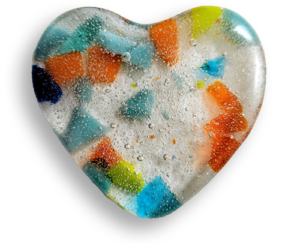


Joy is very appropriately named! This interview is a splash of color in a dark world. It was a fun, inspiring, interesting read. Publishing at 80 years young– wow! I love the suggestion that we just follow what we’re interested in…& we look into improv. I’m looking forward to learning more at the links. Thank you, Diane, for bringing us joy with every blog post 🙂
Aww, Sarita! Thanks for your kind words!
You are a splash of brilliant color in a dark world!!
And, yes, Joy is appropriately named–and definitely 80 years young!
So glad you interviewed Joy! I learned even more about this wonderful friend of mine. She is amazing!
Somehow I have never thought of making the colors of my house match me!
I was astonished to read that Nicky Mendenhall will have a book coming out in October. I never thought I would read that about myself. Thanks so much!
Yes, Nicky! You are having a book coming out–lol!! Must have been fun to read!
And yes, the idea of matching the colors in your house to you–so interesting!
The story of Joy selling the business to her partner who changed it fundamentally just fascinated me. I am so glad she is writing HER book now because that concept is spot on. The identity issue around weight is key and I look forward to reading her perspective, but I wouldn’t read a version that’s infused with biblical teaching. Now so many more people will have access. Thanks, Joy!
Awesome interview!
Thanks, Sherry! I, too, found that part of the interview fascinating and so happy her book will be out soon, giving more people access to her program.
So inspiring! 80 years young! Wonderful to hear her passion.
80 years young is a great way to describe Joy, Denise! Thanks!
Your interview with Joy–quite a powerhouse–reminded me of the Summer I thought I was until I turned 70 and had ‘my colors’ done again. I was much brighter, more of a Spring. Ha, a lifetime of muted colors.
I will certainly check out Joy’s website. Diane, your interviewing style is engaged and focused.
Really good!
Joy is a powerhouse, Greta! Interviewing her was a pleasure!
And I can definitely see you as a bright spring!
Such an interesting interview! For the last couple years, since I turned my hair white and pink, my own palette has changed. Lots of white shirts and light-colored skirts – because my hair is so fundamentally different from the dark brown I was born with. And, the photo of her living room could be the photo of MY living room. So fun.
White and pink hair, Alison! Now that’s fun! It’s so interesting how a change in hair color can change a whole palette.